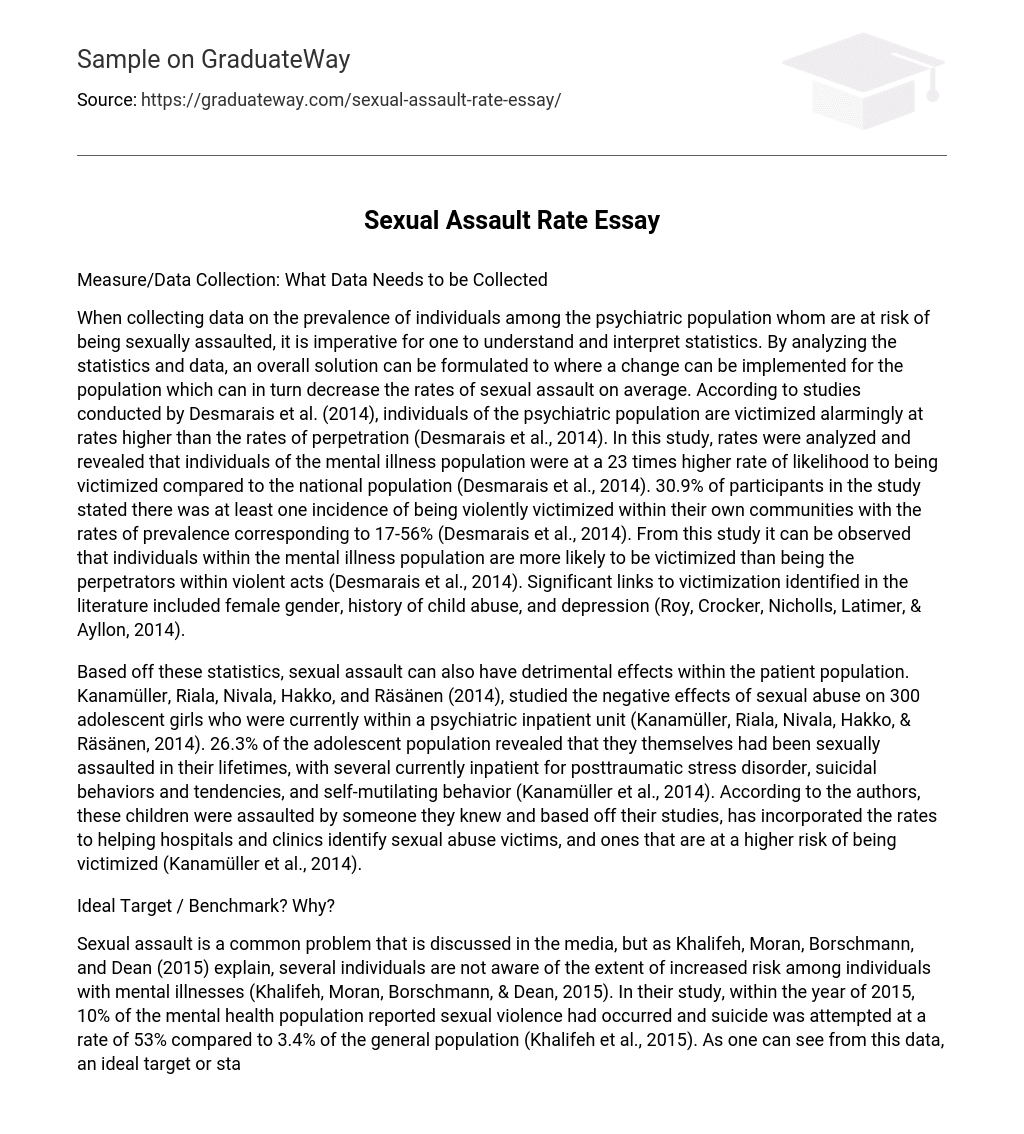Measure/Data Collection: What Data Needs to be Collected
When collecting data on the prevalence of individuals among the psychiatric population whom are at risk of being sexually assaulted, it is imperative for one to understand and interpret statistics. By analyzing the statistics and data, an overall solution can be formulated to where a change can be implemented for the population which can in turn decrease the rates of sexual assault on average. According to studies conducted by Desmarais et al. (2014), individuals of the psychiatric population are victimized alarmingly at rates higher than the rates of perpetration (Desmarais et al., 2014). In this study, rates were analyzed and revealed that individuals of the mental illness population were at a 23 times higher rate of likelihood to being victimized compared to the national population (Desmarais et al., 2014). 30.9% of participants in the study stated there was at least one incidence of being violently victimized within their own communities with the rates of prevalence corresponding to 17-56% (Desmarais et al., 2014). From this study it can be observed that individuals within the mental illness population are more likely to be victimized than being the perpetrators within violent acts (Desmarais et al., 2014). Significant links to victimization identified in the literature included female gender, history of child abuse, and depression (Roy, Crocker, Nicholls, Latimer, & Ayllon, 2014).
Based off these statistics, sexual assault can also have detrimental effects within the patient population. Kanamüller, Riala, Nivala, Hakko, and Räsänen (2014), studied the negative effects of sexual abuse on 300 adolescent girls who were currently within a psychiatric inpatient unit (Kanamüller, Riala, Nivala, Hakko, & Räsänen, 2014). 26.3% of the adolescent population revealed that they themselves had been sexually assaulted in their lifetimes, with several currently inpatient for posttraumatic stress disorder, suicidal behaviors and tendencies, and self-mutilating behavior (Kanamüller et al., 2014). According to the authors, these children were assaulted by someone they knew and based off their studies, has incorporated the rates to helping hospitals and clinics identify sexual abuse victims, and ones that are at a higher risk of being victimized (Kanamüller et al., 2014).
Ideal Target / Benchmark? Why?
Sexual assault is a common problem that is discussed in the media, but as Khalifeh, Moran, Borschmann, and Dean (2015) explain, several individuals are not aware of the extent of increased risk among individuals with mental illnesses (Khalifeh, Moran, Borschmann, & Dean, 2015). In their study, within the year of 2015, 10% of the mental health population reported sexual violence had occurred and suicide was attempted at a rate of 53% compared to 3.4% of the general population (Khalifeh et al., 2015). As one can see from this data, an ideal target or standard for this at-risk population is to decrease the prevalence of sexual assault rates among the psychiatric community. Based off this knowledge, it is necessary to focus on reducing the prevalence of sexual assault rates among the psychiatric community as this can be linked to a decrease in suicide rates, less psychiatric hospitalizations, and other acts of sexual abuse occurring (Khalifeh et al., 2015).
Data Collection Process. Who Will Assist You?
To obtain further data and comprehension of this issue a personal interview with the Director of Nursing at Western State Psychiatric Hospital in Hopkinsville, Kentucky. Western State Psychiatric Hospital is a 240-bed inpatient hospital that treats adults of the mental health population who may be a danger to themselves or to someone else (Kentucky Cabinet for Health and Family Services, 2017). As a past admissions nurse, it was known that this facility’s patient population consisted of individuals’ whom had been sexually abused in their past. On July 20, 2018, April Huycke was interviewed to obtain statistics of patients admitted with a history of being sexually assaulted within the psychiatric setting over the past six months at Western State Psychiatric Hospital. April disclosed that over the past six months, it has been documented on admission assessments that 38% of the new admissions reported a history of sexual assault (Huycke, 2018). April noted that this statistic has remained consistent throughout the years analyzed and that the hospital is focusing currently on identifying assessments to screen patients at the time of admission as often patient’s do not reveal past trauma and then is discovered as a major qualifier for their suicidal tendencies in which they were admitted (Huycke, 2018). April stated that within the next few months, the quality team will be initiating a new screening technique but at this time could not disclose any further details (Huycke, 2018).
A literature review was also conducted to identify data correlated to this issue. According to Kulkarni (2013) 85% of female inpatients revealed that they did not feel safe while hospitalized in a psychiatric facility, 67% reported sexual assault history, and 45% reported being sexually assaulted within the admitted facility (Kulkarni, 2013). In this report, it was noted that the patients did not inform the nursing staff of the assaults in-house as they felt nobody would listen to them (Kulkarni, 2013). To elaborate more on individuals with mental illnesses not reporting sexual assault, Ormon, Sunnqvist, Bahtsevani and Levander (2016) conducted a questionnaire that revealed sexual assault being the least reported type of abuse, and that 44 participants of the medical staff revealed they lacked awarenes of any of the patients’ experiencing sexual abuse in their past (Ormon, Sunnqvist, Bahtesvani, & Levander, 2016). Actions need to be taken to prevent violence and help protect this at-risk population.





